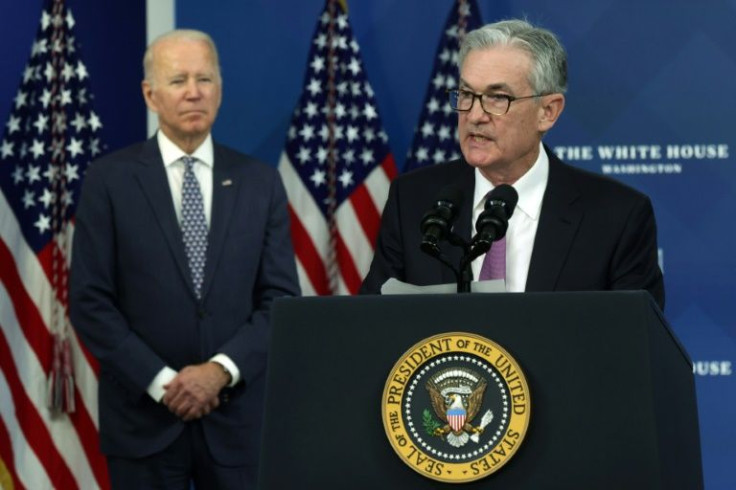US Economy 2022: Here's What Economists Say About Inflation Scares
Inflation has grown into something of a devil in 2021 after laying stubbornly dormant for years. Now, its ominous specter is casting a shadow into 2022 and whether or not it will linger remains an open question.
For policymakers in the White House and the Federal Reserve, inflation has become the dominant concern alongside the continuing battle against COVID-19. Core inflation metrics have recorded levels not seen in decades as the economy began to emerge from the restrictions and disruptions caused by the pandemic.
Economists interviewed by International Business Times agree that inflation is likely to stay here for a while through 2022. What they also agree on is that the reasons center around four familiar problems from 2021: global supply chain bottlenecks, a troubled labor market, and monetary policy. To make matters more complicated, none of these problems have an easy solution.
Dan North, a senior economist at Euler Hermes North America, said that there is a chief actor at the center of this trio of problems today: the Fed.
Why, North explained, is because of what he sees as the central bank’s dovish position in the last year that has left it “behind the curve” in taking a more proactive role in arresting the flight of inflation.
“The situation we have is that emergency conditions we had [at the start of the pandemic] have been in place for two years,” North told IBT in a phone interview. “Too much easy money for too long.”
For much of 2021, the Federal Reserve stuck to a view that inflation would be “transitory,” or that it would be temporary as supply and demand imbalances sorted themselves out. As a result, it held off on pulling back its stimulus policies or on offering signals as to when it may raise interest rates.
However, as core inflation began to surge in the fourth quarter, the Fed changed tact and announced a tapering off of its asset purchasing in November followed by a tentative schedule of interest rate hikes for 2022. North pointed out that this still meant that the Fed’s slow pace in ending its stimulus purchases and its slowness to raise rates is inadequate for stopping inflation’s ascent.

Dr. Elise Gould, a senior economist at the Economic Policy Institute in Washington D.C., took a slightly different tone on the Fed’s intentions for 2022. Gould said that she expects inflation to come down in 2022 and that the Fed may be “overthinking inflation” by acting too soon. Her worry is that the central bank may act too soon by raising rates before the economy reaches the Fed’s intended goal of full employment.
“If they slow economic growth [by raising rates] too soon, we may not return to pre-pandemic employment levels anytime soon,” Gould told IBT. “If they put on the brakes too soon, we may not get there too quickly or at all.”
Despite the restoration of some semblance of normalcy in daily economic activity, the labor force has traveled a rocky path to full recovery. Initial unemployment claims have surpassed pre-pandemic lows and the official unemployment rate is currently at 4.2%, but there are still shortages across sectors and a record number of resignations as 2021 draws to a close.
North, the Euler Hermes economist, said that wage growth has long been the “missing ingredient” to raising inflation to desirable levels, but described the last year’s growth as “nuclear”. Where this contributes to future inflation, North believes, is that today’s wages are likely to remain where they are and leave the pressure on inflation in place in 2022.
“Wages are sticky, they do not come back down,” said North, citing historical trends of positive, if stagnant, growth. “We haven’t seen them [wage growth] in several decades, now we have them, and I think they will be a significant contributor to inflation going forward.”
A number of commentators have suggested that the pandemic has in effect contributed to a surge in workers’ bargaining power as companies compete for their labor. Some companies meanwhile have complained that it has been harder than ever to fill vacancies because of a demand for higher wages or other benefits.
Gould disputes this characterization as overstated. To support her argument, she said that as corporate profits are up, labor’s share of these earnings are not. She added that this in effect shows a lack of leverage on the part of workers to demand higher wages.
“The labor share would be rising if they [corporations] were feeling like they had to pay people more money,” said Gould. “That is not what we’re seeing.”
Instead, Gould posited that rising prices were more likely to do with supply chain bottlenecks than wage increases. Indeed, indices such as the producer price index have shown that prices for many goods have risen which is reflected in other core inflation metrics as well.
Herein lies the tough knot that binds together labor shortages and supply-chain bottlenecks.
According to North, an ongoing shortage of transportation workers, like delivery drivers, is driving up costs further. He added that these shortages — in workers and products — are unlikely to get better soon enough in 2022, and may in fact have gotten off to a worse head start than hoped for.

© Copyright IBTimes 2025. All rights reserved.




















